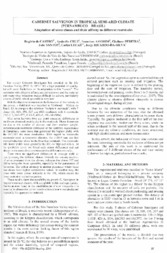Cabernet Sauvignon in tropical semi-arid climate (Pernambuco - Brasil): adaptation of some clones and their affinity to different rootstocks.
Cabernet Sauvignon in tropical semi-arid climate (Pernambuco - Brasil): adaptation of some clones and their affinity to different rootstocks.
Author(s): CASTRO, R. de; CRUZ, A.; AMORIM, F.; PEREIRA, G. E.; SANTOS, J.; LUCAS, C.; SILVA, J. R. da
Summary: The variety Cabemet Sauvignon has revealed in the São Francisco Valley (9°02' S; 40°11' W) a high potential of quality, but with some limitations on its adaptation to this "terroir". The rootstocks with effective aftinity are yet unknown and the material with many virus infections makes difficult its culture, particularly in terms ofyield, which generally is very low. With the objective to maximize the behaviour ofthis variety in this terroir, a field trial was installed in Vinibrasil - Vinhos do Brasil, SA to compare the relations "variety x rootstock", with 5 clones (15, 169, 191,337 and 685) combined with 6 rootstocks (IAC-313, IAC-572, 1103-P, 420-A, 101-14 e S04). After seven harvests (two per year) consistent differences in yield were observed, mainly due to the rootstock. These disparities are due to the number of clusters and their medium weight. Autochthonous rootstocks (obtained at the Instituto Agronômico de Campinas), were those that generated the highest yield, with the IAC-313 the most productive. With regard to rootstocks commonly used in temperate climates, the 1103-P was one that showed behaviour closer to the Brazilian rootstock. The rootstocks with lower yields were generally the 101-14 Mgt and 420-A. At the qualitative level, we found only minor differences and not always in the same direction between the different rootstocks. There were no significant differences in average yield or quality among the different clones. Overall, the sensory analysis of wines produced from the clones, indicates the clones 337 and 685 as being the most agreeable, especially in the parameters of the aroma. The colour intensity is another parameter where those two clones have higher comparative values. In another way, the clone with lower colour intensity is the 191, which shows the lower content of red anthocyanins. These results show the possibility to growth C. Sauvignon in tropical semi-arid climate, with acceptable yields and high quality. On the another hand, in the establishment of new vineyards it is essential to choose the correct combination (clone x rootstock) and especially the appropriate rootstock.
Publication year: 2011
Types of publication: Paper in annals and proceedings
Unit: Embrapa Semi-arid Region
Keywords: Clima, Grapes, Porta-enxerto, Uva
Observation
Some of Embrapa's publications are published as ePub files. To read them, use or download one of the following free software options to your computer or mobile device. Android: Google Play Books; IOS: iBooks; Windows and Linux: Calibre.
Access other publications
Access the Agricultural Research Database (BDPA) to consult Embrapa's full library collection and records.
Visit Embrapa Bookstore to purchase books and other publications sold by Embrapa.

